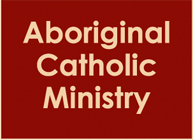Richard Campbell
About the paintings: Madonna and Child | Crucifixion | Resurrection
As a little boy, Richard would help his dad paint shields, spears and boomerangs. He would sketch pictures for his dad who would burn them into the wood and then Richard would put the paint in the design for his dad. “Dad would sell them for food or beer, we were never hungry. If there was no money, dad would kill a roo or wallaby or take us fishing. We never went without.” The next few years of Richard’s childhood were spent on the move, with mum always trying to stay one step ahead of dad and one step ahead of the welfare board; always in the background watching, waiting to take the kids away. They travelled from town to town, living in places like Redfern, Erskineville and Lewisham. Richard first went to school in Blacktown, in a converted airplane hangar. When he recalls his early school years he says, “the Church was always there.”
It all came to an end one bleak day, when they lived in Bowraville. “We saw a big black car roll up and we knew it was coming to take us away.” He was 9 years old. The black car took them all to the Macksville Court House. From there the boys were sent to Kinchela Boys Home and the girls were sent somewhere else. They were never permitted to know the whereabouts of their sisters. Over the next 5 or 6 years Richard and his brothers were shunted from boys’ homes to foster homes and back again.
After his family was separated, Richard remembers more bad than good. He was in and out of trouble, but it wasn’t until Fr Tony Stace in Broadmeadow asked Richard to do a painting to connect Aboriginal spirituality with the Bible stories that he began to develop his gift. When Richard started to paint, he felt his own spirituality come flooding back and he began to remember the stories of his people, noticing the similarity between Aboriginal stories and the Christian stories.
When Richard undertook TAFE classes to study technique his teachers recognised in him a profound talent and depth in his work. It was the teachers at TAFE who encouraged Richard to further his education so that he could share his knowledge. He completed a 3 year degree in visual arts at Deakin University in Geelong. He has come full circle and now he is the one teaching the kids about art and spirituality and they look up to him. Richard tries to tell them that they can do it too, that they just have to continue their education and they can be like him too.
Like Richard’s father, his sister Louise Campbell has been a strong influence in Richard’s life and work. With the same sense of social justice and relentless drive to right the wrongs against Aboriginal people, Louise has encouraged Richard to tell his story in his paintings to open up people to the story of Aboriginal people.
Asked what he wants Aboriginal and non-Aboriginal people to get from his art, he reiterates: “We all have a spiritual connection, we’re all brothers and sisters, with the animals, the trees, rivers and rocks, we all belong to one big god – call it Christ, we call it Birrigun, we are all one in God.”
In the future Richard hopes to do more paintings about being part of the Stolen Generation, and how it has made him feel, but not just for himself but for all the people he has known throughout his years, his brothers and sisters, his aunts and grandparents and the other Aboriginal children and men he shared his youth with in the homes and institutions, most of whom have passed away now or are near enough, because of the abuse they suffered through the years. “In Kinchela, boys came from all around NSW, we were like one big family, we stuck together and looked after each other, most of them have returned to the dreaming now.” It’s time to tell their story.
Richard was a finalist in the prestigious 2007 Blake Prize for religious art and his art will be used extensively in the marketing and merchandising of World Youth Day 2008, an international event being held in Sydney in July 2008. For more information or to purchase some of Richard’s work email oursacredspace@live.com.au .
In 2010 the Mary Mackillop Institute requested the use of two of his works to be used in the Canonisation Ceremony. Richard was fortunate enough to travel to Rome to witness the event.
